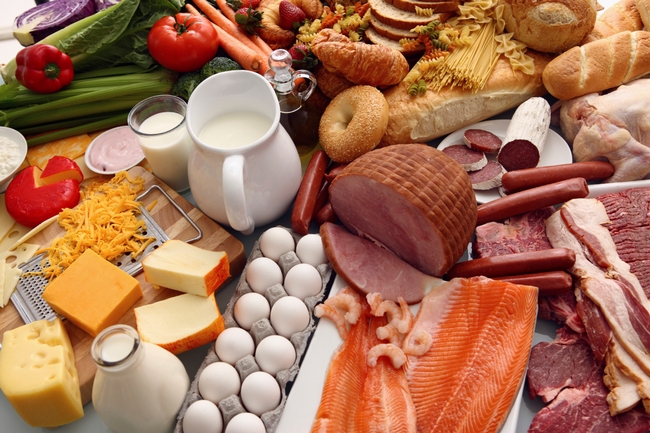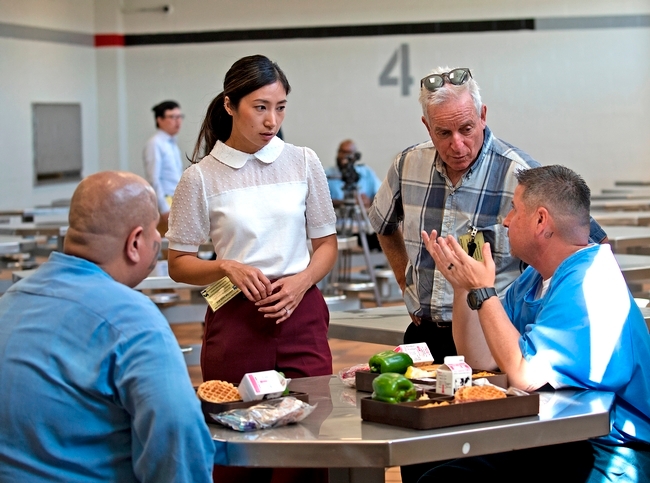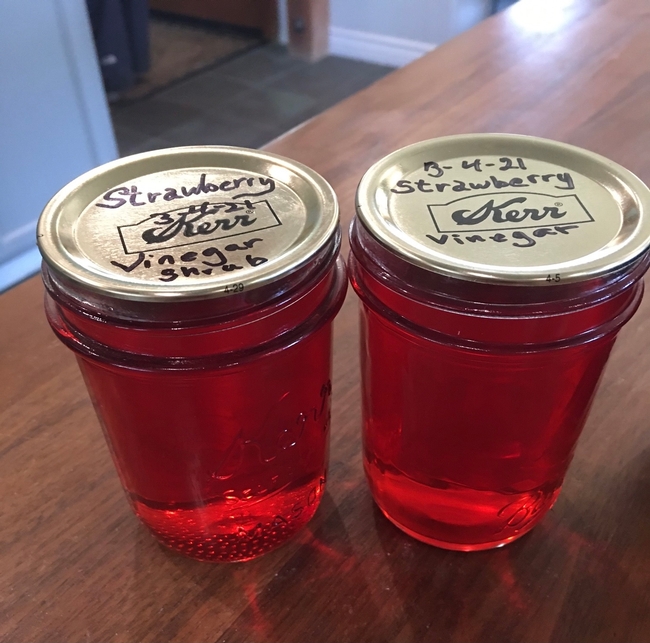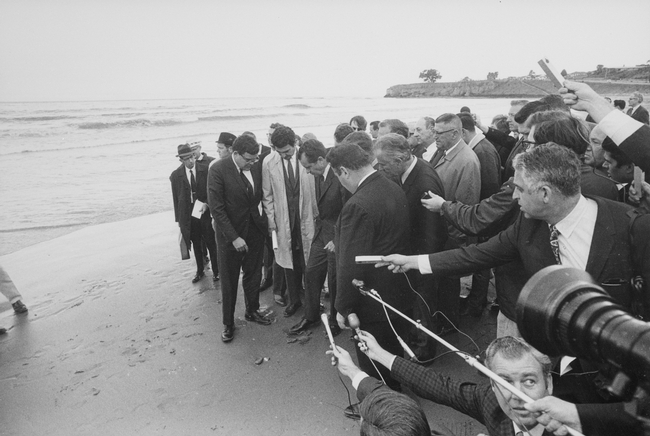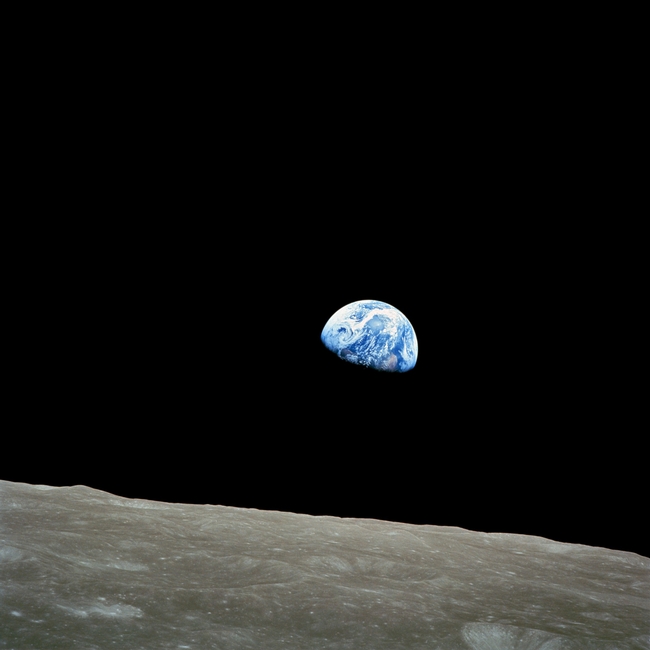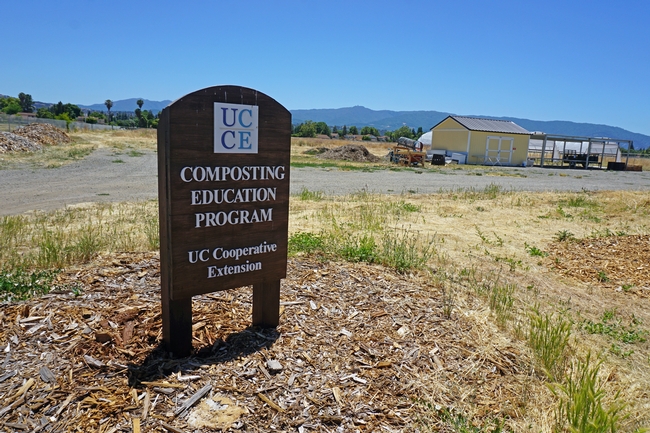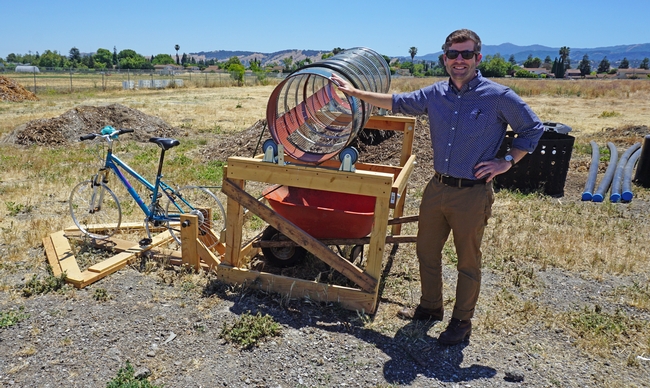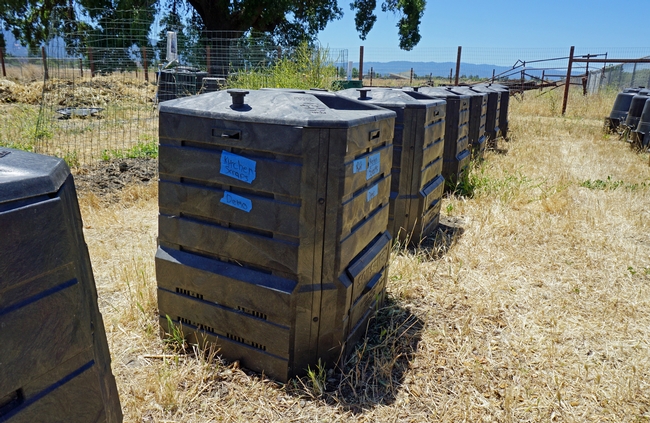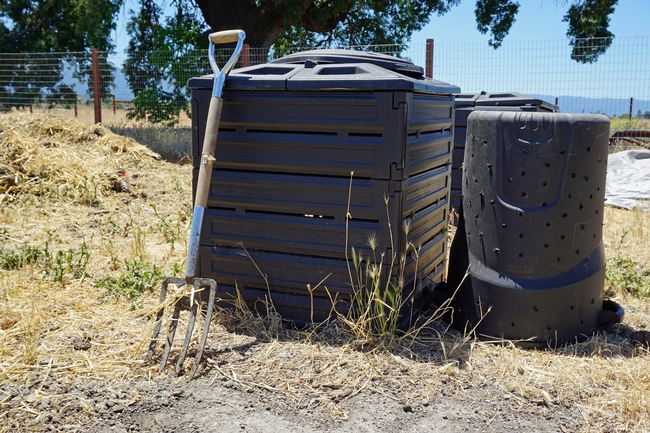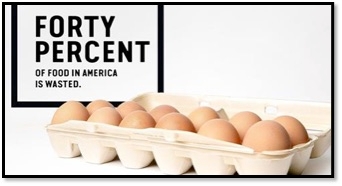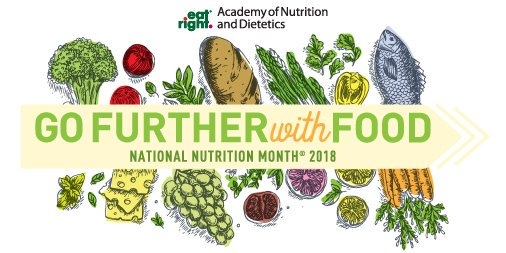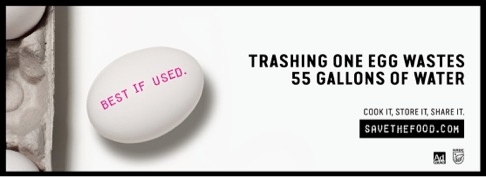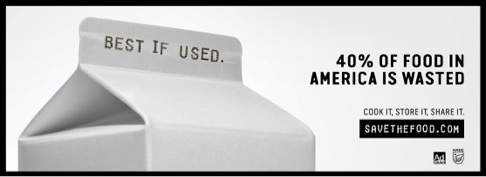Posts Tagged: food waste
Food waste, nutrition in prison focus of webinars Feb. 22, 29
Free webinars about food waste and nutrition in correctional systems will be presented by the University of California Agriculture and Natural Resources.
The UC ANR Sustainable Food Systems Emerging Issues Webinar Serieswill first cover food waste on Feb. 22.
“The Sustainable Food Systems strategic initiative panel aimed to highlight innovative solutions to emerging issues within the food system from field-to-fork,” said Danielle Lee, UC Nutrition Policy Institute director of communications and research engagement.
“Over one-third of all available food in the U.S. is uneaten through food loss or waste – totaling up to over $160 billion – which has negative impacts on food security and the climate,” she said. “Households could save over $370 per person each year by reducing or preventing food waste. Additionally, when uneaten food ends up in the landfill, it generates greenhouse gases, and landfills are now the third largest producers of methane in the U.S.”
“California's adoption of SB 1383 aims to solve these problems,” Lee said. “You'll meet experts who are implementing consumer education and organic waste recycling programs aligned with SB 1383.”
The second 90-minute webinar, on Feb. 29, will focus on nutritious foods for residents of correctional facilities.
“We chose incarcerated people as our case study population for two reasons – the California Department of Corrections and Rehabilitation is the single largest public purchaser of food in the state and studies have shown that 63% of incarcerated individuals rarely or never have fresh vegetables and 55% rarely or never have fresh fruit.”
California has two policies that can support institutional procurement of fresh produce – AB 822 and AB 778.
“The Harvest of the Month program is an innovative solution to implementing these policies while supporting improved nutrition security for incarcerated individuals,” Lee said. “Prison gardening programs can not only provide therapeutic benefits to residents, but also reduce recidivism rates and serve as workforce development opportunities to better prepare residents for returning to their communities post-incarceration.”
Part 1 - Harvesting Solutions: A Trio of Perspectives on Addressing Food Waste from Field to Fork
Thursday, Feb 22, at 10-11:30 a.m. PT
To minimize food waste, three experts explore factors influencing food loss and waste, delve into innovative recycling techniques, and explore statewide initiatives targeting household food waste. Experts in postharvest handling, food waste recycling and community education will share research findings and strategies.
Agenda:
- An overview of food waste in fruits and vegetables
Deirdre Holcroft, Holcroft Postharvest Consulting - Exploring means to extract embodied energy and lower greenhouse gas emissions in food waste recycling
Michael Cohen, UC Cooperative Extension organic materials management and agri-food systems advisor for Santa Clara County - The opportunities in statewide programs in reducing household food waste: Results from UC ANR household food practice needs assessment
Yu Meng, UC Cooperative Extension youth, family and community advisor in Riverside, San Bernardino and Imperial counties
Part 2 - Farm to Corrections: Cultivating Justice through Nutrition and Gardening Initiatives
Thursday, Feb. 29, at 10-11:30 a.m. PT
Experts share insights on groundbreaking initiatives for justice-involved individuals' access to California-grown produce and nutrition and gardening education. Innovative initiatives such as a “Harvest of the Month” program by the California Department of Corrections and Rehabilitation in collaboration with the UC Nutrition Policy Institute and Impact Justice aim to increase access to fresh, locally grown fresh fruits and vegetables and trauma-informed nutrition workshops. They also highlight the impact of UC Master Gardener projects on rehabilitation and workforce development.
Agenda:
- Produce during and after prison: Increasing justice-impacted individuals' access to California-grown produce and nutrition education
Carolyn Chelius, UC ANR Nutrition Policy Institute; Heile Gantan, Impact Justice; Lance Eshelman, California Department of Corrections and Rehabilitations - UC Master Gardeners Prison Gardens Projects
Missy Gable, director of the UC Master Gardener Program
Learn more and register at https://ucanr.edu/sites/StrategicInitiatives/Sustainable_Food_Systems/Events.
UC Master Food Preservers turn food scraps into gifts Dec. 1
Free online class offers recipes for using food scraps, answers questions about food preservation
“Putting food in our bellies instead of landfills is good for the planet,” said Sue Mosbacher, University of California Master Food Preserver Program coordinator. In landfills, decaying food releases methane, a greenhouse gas that contributes to climate change.
“We can reduce food waste and save money by creating new foods from food scraps,” Mosbacher said. “Instead of throwing away a lemon peel after squeezing out the juice, use the lemon zest to make lemon curd or citrus salt. They make wonderful homemade gifts for the holidays.”
UC Cooperative Extension Master Food Preservers, a program of UC Agriculture and Natural Resources, provides ideas for using leftovers and advice for safely preserving food.
On Dec. 1, 6:30 to 7:30 p.m., UCCE Master Food Preserver volunteers of Amador and Calaveras counties will host a free online class to show samples of apple honey, citrus salt, strawberry vinaigrette, sugared walnuts and lemon curd. Recipes will be emailed to participants.
“Many of these gifts are inexpensive to make because you're using food scraps – such as lemon rind or apple peel – and a few other ingredients. You can put the citrus salt in jars you've saved,” Mosbacher said. “It is easy to make and there's no special equipment needed.”
After the “show and tell” session, the UCCE Master Food Preserver volunteers will answer participants' questions about freezing, dehydrating and canning foods and food safety.
Because the class is online, anyone can participate, regardless of their location. Register for the one-hour Zoom workshop at https://mfp.ucanr.edu/Events/?calitem=516566.
The UCCE Master Food Preserver Program extends UC research-based information about home food safety and preservation to the public throughout the year. UCCE Master Food Preserver volunteers are located in 19 counties of California, most recently certifying volunteers in Modoc County, where they are offering pressure canner testing.
UCCE Master Food Preserver volunteers host monthly workshops on the first Wednesday of each month, with hosting duties rotating between Sacramento, El Dorado, Amador and Calaveras counties.
For 2022, the UCCE Master Food Preservers of Sacramento County are planning to offer the following workshops via Zoom:
- Jan. 19 – Citrus for Super Bowl
- Feb. 16 – Dehydration for Soups
- March 16 – Soups & Roots
- April 20 – “Night of Fermenting” Cheese/Yogurt/Sauerkraut
- May 18 – Jams & Jellies
- June 15 – “Ready for BBQ Season” Condiments & Beverages
- July 20 - Red, White & Blue
- Aug. 17 – “Tomato Mania” Salsas, Sauces & Peppers
- Sept. 21 – Sausages & Mustards
- Oct. 19 – “Apples, Pears & Persimmons Oh My”
- Nov. 16 – Sides Dishes for your Holiday Dinner
- Dec. 21 – Quick Gifts
To sign up for any of the workshops above, visit https://sacmfp.ucanr.edu.
To find other upcoming UCCE Master Food Preserver Program events, visit https://mfp.ucanr.edu/Events. To find a program in your county, visit https://mfp.ucanr.edu/Contact/Find_a_Program.
Resources for preserving food and more information about the UCCE Master Food Preserver Program are available at https://mfp.ucanr.edu.
Earth Day history can inspire us all
My father was ahead of his time.
Years before Americans were asked to, Jim Hayden ensured that our family conserved energy by keeping the thermostat low, turning off lights and taking "military" showers to reduce water use. My father also observed the speed limit. Our family vacations took us to national parks. I grew up with a keen appreciation for the outdoors. I remember the sense of horror and helplessness when I saw the images of distressed wildlife in the aftermath of the Santa Barbara oil spill, which devastated the beaches that were an important part of our family's life.
In part as a result of that oil spill, Earth Day came into being. And 49 years after that inaugural Earth Day event, many of us will find ourselves at a gathering dedicated to increasing awareness of the environment that supports and sustains us all.
History of Earth Day
Earth Day was launched in 1970. Many factors contributed to the call for a national day focusing on environmental stewardship, including the publication of Rachel Carson's Silent Spring - serialized in the New Yorker - and the catastrophic oil spill that occurred off the coast of Santa Barbara in 1969. The Santa Barbara oil spill galvanized U.S. Senator Gaylord Nelson (D-Wisconsin) to call for a national day of locally inspired and organized "teach-ins" on the environment - a national "Earth Day." The Earth Day model was inspired by the spirit of campus activism at the nation's colleges and universities. It wasn't top-down, but rather a grassroots effort that encouraged communities to develop educational and service events around issues and topics important to them.
Earth Day struck a chord; some estimates suggest that 1 in 10 Americans participated in the first events. Earth Day is widely credited with "sparking" the modern environmental movement. Landmark environmental legislation swiftly followed (including the Clean Air Act, Clean Water Act and Endangered Species Act). The Environmental Protection agency was founded that same year. Twenty years after its launch, Earth Day became a global movement.
You can learn more from the Earth Day Network by linking to this website.
Take part. Learn. Act.
UC ANR research efforts support a healthy and sustainable environment
UC ANR is dedicated to supporting a healthy and sustainable environment. It's part of our core mission. Highlighted below are just a few of the many projects we're working on to protect California's natural resources, build climate-resilient communities and ecosystems, and promote healthy people and communities.
Seeking Street Trees that Can Cope With Climate Change
Trees play a vital role in shading and beautifying California's urban areas. UC ANR researcher Janet Hartin says that:
“Urban areas create heat islands, with dark asphalt surfaces reradiating heat. Cities can be 10 to 20 degrees warmer than the surrounding environment."
Trees provide other benefits, including improving soil health and stability, providing habitat for wildlife and serving as a source of beauty. But climate change (resulting in reduced rainfall and higher temperatures) can create chronic stress in some street tree species.
To find a solution, UC Cooperative Extension scientists are partnering with the U.S. Forest Service "in an unprecedented 20-year research study to expand the palette of drought-adapted, climate-ready trees for several of the state's climate zones."
“The idea is to look at available but under-planted, drought-tolerant, structurally sound, pest resistant trees for Southern California that do well in even warmer climates,” said Janet Hartin, UCCE horticulture advisor in San Bernardino County.
Learn more - including what tree species might be planted in your area - in this terrific read by Jeannette Warnert.
CDFA and UC ANR join forces to advance Climate-Smart Ag
A new partnership between the California Department of Food and Agriculture (CDFA) and UCANR aims to advance climate-smart ag in California. More than $1 million has been used to hire 10 UC Cooperative Extension community education specialists, who are being deployed to 10 counties to help farmers participate in CDFA programs that increase the adopting of "smart" farming and ranching practices.
The primary focus is putting into action on-farm solutions to improve (and increase) smart farming practices that reduce greenhouse gas emissions. Practices that improve soil health, nutrient management, irrigation management, and more will be emphasized.
Learn more about this innovative program here.
Be kind to the Earth by reducing food waste
Nearly 40 percent of the food produced in the U.S. is wasted and much of that waste ends up in landfills (definitely not good for our environment or the economy). The National Resources Defense Council estimates that the average family of four throws out nearly 1,000 pounds of food each year, wasting roughly $1,500. Consumers as a group waste more food than farms, grocery stores or restaurants. For tips on ways you can reduce #FoodWaste, click here. Related Reading: What a World War I Poster Can Teach Us About #FoodWaste.
4-H Sustainable You! summer camp to be offered in Ventura County
The UCCE Ventura County team will once again be hosting its week-long 4-H Sustainable You! summer day camp at UC's Hansen Agricultural Research and Extension Center (HAREC) in Santa Paula. Campers aged 9-12 are invited to spend time on a working farm, learning what it means to be sustainable through fun activities based around the five major themes: Air, Land, Energy, Water, and Food. Registration information can be found here.
For more than 100 years the UC ANR 4-H Youth Development Program has taught generations of California children about food, agriculture, leadership, and community service using learn-by-doing practices. The California 4-H Science, Engineering and Technology (STEM) Initiative seeks to increase science literacy and help address the growing need for scientists, engineers, and technical experts. 4-H empowers youth with the skills to lead for a lifetime.
Interested in learning more about 4-H in your community? Visit our statewide 4-H program page.
The above photo is one of my favorites. It was taken by Apollo 8 astronaut Bill Anders on Dec. 24, 1968, while in orbit around the moon. It shows the Earth rising for the third time above the lunar horizon. It always serves to remind me that my individual actions do matter, and when considered with the actions of others, contribute to real change ... the "moon shot." Have a great Earth Day!
Reduce food waste to combat world hunger and slow global climate change
One-third of the world's food is spoiled or tossed rather than eaten, a fact that is tragic when nearly one billion people go hungry. The injustice of food waste is worsened by the fact that food decomposing in landfills emits greenhouse gases that contribute to climate change.
The conventional management of municipal waste in landfills places discarded food and plant matter into an anaerobic environment, initiating a chemical reaction that turns biomass into biogas – specifically methane, a greenhouse gas that's 28 times more potent than carbon dioxide.
Reducing the volume of the California waste stream and reducing the emission of greenhouse gases into the atmosphere are objectives that have spurred state lawmakers to enact regulations, such as Assembly Bill 939, which in 1985 mandated a 50 percent diversion of solid waste away from landfills. A 1989 update to the law also required municipalities to reach out to residents with training on greenwaste etiquette and waste diversion.
UC Cooperative Extension is working closely with the cities and county of Santa Clara in a far-reaching program to divert organic matter – food and green waste – from landfills by composting and using the product to enrich soil in the home garden.
In early June, UC Master Composter Don Krafft conducted a class on composting in a Palo Alto community center, one of 22 sessions to be offered in the spring and summer of 2018. A retired telecommunications professional, Krafft's interest in composting stemmed from his work as a Master Gardener for UC Cooperative Extension.
“I live in a townhouse, so I do worm composting. The No. 1 reason,” Krafft said, “is because it's fun.”
The composting workshops are just one component of the UC Cooperative Extension's composting efforts in Santa Clara County, led by UCCE staff research associate Cole Smith. The Environmental Protection Agency has a food recovery hierarchy, he said, which has source reduction at the top, followed by feeding the hungry, feeding animals, industrial uses, then composting, and finally delivery to a landfill.
“By diverting and recycling at the source, we reduce the diesel footprint for hauling,” Smith said. “We want to tighten the nutrient loop and the backyard is the closest place.”
The classic composting technique involves layering “browns” – dry leaves, sawdust, woody cuttings, straw, shredded newspaper and cardboard – with “greens” – grass clippings, food scraps, coffee grounds, egg shells, green plant cuttings and manure.
“Start and end with browns to keep the fruit flies down,” Krafft said. “It's like making lasagna.”
Certain foods should not be added to the home compost heap – including meat, whole eggs and dairy products.
The mix of greens and browns should be maintained evenly moist, but not soaked, and turned at regular intervals, the more often, the faster the materials decompose.
“Maintenance is completely adaptable. You can do a lot or a little and it gets easier with time,” Krafft assured the audience.
The compost is ready when the components are no longer recognizable and the pile is cold. Once composted, the former waste becomes a stable soil amendment with a pleasant earthy smell. It's then ready to be applied in the garden.
UCCE Santa Clara has also developed a three-acre composting demonstration site at Martial Cottle Park in San Jose, where volunteers are composting animal waste generated by the 4-H animal program in a project made possible by a grant from the Santa Clara Valley Water District.
The facility includes a variety of commercial and homemade compost containers, including one built by a volunteer that employs bicycle power to mix compost.
The issue of food waste is capturing significant attention not only in Santa Clara County and not only in the garden. Food waste reaches across multiple disciplines, including agriculture, environment, and public health, key areas of UC Agriculture and Natural Resources' efforts.
“Food waste is a symptom of our food systems and food practices going astray,” said Wendi Gosliner, a project scientist in the UC ANR Nutrition Policy Institute, co-founder of California Food Waste Prevention Week, which was held for the first time in March 2018.
“Addressing the issue requires researchers, practitioners, policy makers, communities and individuals to innovate and develop new solutions,” Gosliner said.
UC ANR programs that have a hand in food waste prevention include:
- Nutrition education programs – UC CalFresh and the Expanded Food and Nutrition Education Program – which teach families how to eat right and economize
- The UC Master Food Preserver Program, which offers training on canning, freezing, drying, fermenting and other techniques to preserve a summertime food bounty to eat later
- The 4-H Youth Development program, which trains youth in recycling and is providing animal manure for the Santa Clara compost demonstration site
- The UC Master Gardener Program, which endorses the use of homemade compost
- Nutrition Policy Institute, which conducts research that informs nutrition policy and programs for healthy children, families and communities
“UC ANR translates research to practice in helping communities manage food resources, learn to preserve food and compost – all parts of the food waste solution,” Gosliner said. “Thinking about these and other UC ANR activities under the umbrella of food waste prevention can help to better nourish people, protect the environment and conserve human, natural and financial resources.
Announcing California's inaugural Food Waste Prevention Week
UC Agriculture and Natural Resources and the Nutrition Policy Institute are pleased to announce March 5 - 9, 2018, as California's inaugural Food Waste Prevention Week. During this week, a range of partners statewide, including the Governor, the Secretary of Agriculture, the State Superintendent of Public Instruction, as well as many other agency leaders in public health, natural resources management, nutrition, and other sectors, are coming together in an unprecedented collaboration to raise awareness about the impacts of food waste in our homes, workplaces and communities.
This collaboration grew out of a meeting held in February 2017 in which the Public Health Alliance of Southern California and the UC ANR Nutrition Policy Institute jointly convened state agencies delivering nutrition education programming to discuss the impacts of food waste and strategize solutions the agencies could advance together. The planning group identified an opportunity to generate and issue shared messaging during National Nutrition Month, a goal that has evolved into California's inaugural Food Waste Prevention Week, a coordinated multi-sector effort to raise awareness about the economic, environmental and social impacts of food waste in California.
Food waste is a significant issue. The United States is losing up to 40% of its food from farm to fork to landfill. That translates to $218 billion lost, including costs of food to consumers and retailers, as well as costs of wasted water, energy, fertilizer, cropland, production, storage and transportation. CalRecycle estimates that Californians throw away almost 12 billion pounds of food each year – 18% of all landfill use in this state. The food in landfills decomposes and releases methane, a powerful greenhouse gas linked to climate change.
In addition, that food loss could have fed people, not landfills, if only it had been used, instead of tossed. In California, nearly 5 million people are food insecure, lacking consistent access to enough food. Roughly 1 in 8 Californians are experiencing hunger, and 1 in 5 of those are children.
Reducing food waste requires action by partners throughout the food system. During Food Waste Prevention Week, stay tuned to the Nutrition Policy Institute Twitter page and the UC ANR Twitter and Facebook pages for food waste prevention resources, tips and ideas.
You can also share food waste prevention ideas by participating in the Food Waste Reduction Hero Photo Challenge. Simply take a few photos that show how food waste happens in your home, workplace or community and what actions/changes you're making to reduce food waste. Share your submissions via social media platforms using the hashtag #SaveTheFoodCA and tag @SaveTheFood on Twitter and/or Instagram, or email your submissions to SaveTheFoodCA@gmail.com. Please include your location.
For more about Food Waste Prevention Week, read Rose Hayden-Smith's UC Food Observer article, see the Nutrition Policy Institute's Research to Action news brief, and watch UC ANR Vice President Glenda Humiston's video.
Even incorporating a few simple food waste prevention actions has great potential to reduce food waste in California. Your efforts to be a Food Waste Reduction Hero this week, and into the future, will make an impact.
Thank you for helping to make a difference during this inaugural California Food Waste Prevention Week!

